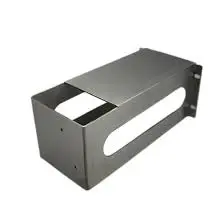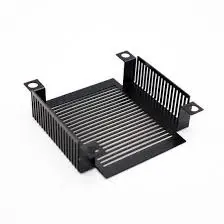How are Bend Electronic Housing Parts Manufactured?
2025-03-13 10:18:47
The manufacturing of bend electronic housing parts represents a sophisticated blend of precision engineering and advanced metal fabrication techniques. At Qingdao RUIRUI Machinery Co., LTD, the production of high-quality bend electronic housing parts involves a meticulous process that combines sheet metal fabrication, die casting, and various surface treatments including polishing, oxidation, painting, and electroplating. These components are critical in protecting sensitive electronic equipment across various industries such as machinery and equipment, electrical appliances, and automotive parts, where durability and precision are paramount.

Advanced Manufacturing Techniques for Bend Electronic Housing Parts
High-Precision Stamping Process
The journey of manufacturing bend electronic housing parts begins with high-precision stamping. Using advanced stamping equipment paired with high-precision molds, RUIRUI Machinery achieves exceptional accuracy in the stamping and forming of metal sheets. This precision is crucial as it ensures dimensional accuracy can be controlled within extremely tight tolerances, typically within fractions of a millimeter.
Such precision guarantees that bend electronic housing parts fit perfectly with internal electronic components, eliminating assembly issues caused by dimensional deviations. The stamping equipment at RUIRUI allows for precise adjustment of parameters such as pressure and stroke, enabling the creation of complex features like holes, card slots, and protrusions with remarkable clarity and accuracy. This level of detail is essential for meeting the intricate design requirements of modern electronic housing components, where even minor imperfections can compromise functionality and aesthetics.
Material Selection and Preparation
The selection of appropriate materials is a critical factor in the production of high-quality bend electronic housing parts. RUIRUI specializes in processing various metals including mild steel, coated steel, aluminum alloys, cold-rolled steel, stainless steel, copper, and brass. Each material offers distinct advantages depending on the specific application requirements. For instance, aluminum alloys provide an excellent strength-to-weight ratio for lightweight electronic housings, while stainless steel offers superior corrosion resistance for devices exposed to harsh environments.
Before the actual manufacturing begins, these materials undergo thorough preparation processes to ensure optimal quality. This preparation may include cleaning, degreasing, and surface treatment to enhance adhesion for subsequent processes. The versatility in material handling capabilities allows RUIRUI to customize bend electronic housing parts according to specific customer requirements, adapting to various use scenarios and performance specifications through corresponding process adjustments and material pretreatment techniques.
Precise Bending Technology
The hallmark of bend electronic housing parts lies in the precision bending operations performed on stamped sheet metal components. RUIRUI employs professional bending equipment and advanced technology to achieve bending angles accurate to several decimal places. This extraordinary precision ensures the overall shape and smooth contours of the housing, contributing significantly to the aesthetic appeal and functional design of electronic devices. The sophisticated bending process implemented at RUIRUI effectively prevents common defects such as cracking, warping, or deformation at bending points.
This is crucial for maintaining the structural integrity and stability of the sheet metal components, providing reliable protection for sensitive electronic equipment housed within. The combination of precise tooling, experienced operators, and computer-controlled bending machines allows for consistent results across large production runs, ensuring that each bend electronic housing part meets stringent quality standards in terms of both form and function.
Quality Control Systems in Bend Electronic Housing Parts Production
Comprehensive Inspection Protocols
Quality assurance forms the backbone of RUIRUI's manufacturing process for bend electronic housing parts. The company has implemented a robust inspection system that begins with incoming material verification and continues throughout the entire production cycle. Each batch of raw materials undergoes thorough testing to verify compliance with specified material standards and properties. During production, bend electronic housing parts are regularly sampled for dimensional accuracy using precision measurement tools such as coordinate measuring machines (CMMs) and digital calipers.
These measurements are compared against design specifications to ensure strict adherence to tolerances. Visual inspections are also conducted to identify any cosmetic defects or finish imperfections that might compromise the appearance or functionality of the electronic housing. The final inspection includes functional tests to verify that components assemble correctly with mating parts. This comprehensive inspection protocol ensures that every bend electronic housing part leaving RUIRUI's facility meets or exceeds industry standards and customer expectations.
Advanced Testing Methodologies
Beyond basic inspection, RUIRUI employs sophisticated testing methodologies to validate the performance and durability of bend electronic housing parts. Environmental testing exposes components to simulated conditions they might encounter during use, such as temperature extremes, humidity, and vibration. These tests help identify potential weaknesses before products reach customers. Mechanical strength testing evaluates the ability of bend electronic housing parts to withstand physical stress, including impact resistance and load-bearing capacity.
Corrosion resistance testing is particularly important for housings that will be exposed to potentially corrosive environments. RUIRUI utilizes salt spray testing and other accelerated aging techniques to assess long-term durability. Electrical safety testing ensures that metal housings provide appropriate shielding and grounding for electronic components. By incorporating these advanced testing methodologies into their quality control system, RUIRUI can guarantee that their bend electronic housing parts will perform reliably under real-world conditions, reducing the risk of field failures and enhancing product longevity.
Certification and Compliance
RUIRUI's commitment to quality is further demonstrated by their adherence to internationally recognized standards and certifications. The company has obtained ISO 9001 quality management system certification, ISO 14001 environmental management system certification, ISO 20000 service management certification, and OHSAS 18001 occupational health and safety management certification. These certifications ensure that bend electronic housing parts are manufactured in accordance with globally accepted best practices.
RUIRUI's quality management team works closely with customers to ensure that products comply with industry-specific standards relevant to their application. For electronic housings, this may include electromagnetic compatibility (EMC) requirements, ingress protection (IP) ratings, or specific regulatory standards for medical or automotive applications. The quality documentation system at RUIRUI creates detailed product quality files from the beginning of production, recording the manufacturing process of each product. By following ISO and IAFT quality standards, RUIRUI maintains strict control over the quality of each bend electronic housing part, providing customers with confidence in the reliability and consistency of their products.
Surface Treatment Options for Bend Electronic Housing Parts
Electroplating and Anodizing Processes
Surface finishing plays a crucial role in enhancing both the aesthetic appeal and functional properties of bend electronic housing parts. RUIRUI offers comprehensive electroplating services that apply thin layers of metals such as zinc, nickel, chrome, or copper to the surface of the housing components. These plated coatings provide multiple benefits including improved corrosion resistance, enhanced electrical conductivity, and superior wear resistance. For aluminum bend electronic housing parts, anodizing is the preferred treatment method. This electrochemical process creates a durable, porous oxide layer on the aluminum surface that can be dyed in various colors while providing excellent corrosion protection.
The controlled thickness of the anodized layer can be tailored to meet specific requirements, typically ranging from 5 to 25 microns depending on the application. RUIRUI's advanced electroplating and anodizing lines include precise control of chemical baths, current density, and process timing to ensure consistent results. These surface treatments not only protect bend electronic housing parts from environmental factors but also contribute significantly to their overall performance and longevity in various application environments.
Powder Coating and Painting Solutions
For applications requiring excellent insulation properties and a wide range of color options, RUIRUI provides powder coating and painting solutions for bend electronic housing parts. The powder coating process begins with thorough surface preparation, including cleaning and pretreatment to ensure optimal adhesion. Electrostatically charged powder particles are then sprayed onto the metal surface before being cured in an oven to form a smooth, uniform coating. This method creates a durable finish that is resistant to chipping, scratching, fading, and wearing.

RUIRUI's fully automated robot production line and advanced thermoplastic coating processes ensure exceptional quality and consistency. Liquid painting offers additional flexibility for achieving specialized finishes such as metallic effects, textured surfaces, or custom color matching. Both powder coating and painting can be applied to various metal substrates used in bend electronic housing parts, providing not only decorative finishes but also functional benefits such as electrical insulation, chemical resistance, and UV protection. The company's emphasis on environmentally friendly coating solutions aligns with their ISO 14001 certification, utilizing low-VOC formulations and efficient application methods to minimize environmental impact.
Specialized Surface Treatments
Beyond standard finishing options, RUIRUI offers specialized surface treatments that address specific performance requirements for bend electronic housing parts. Polishing processes range from mechanical buffing to chemical polishing, achieving various levels of surface smoothness and reflectivity. These treatments are particularly important for housings with aesthetic considerations or those requiring specific surface characteristics for assembly or sealing. Deburring operations remove sharp edges and burrs resulting from the stamping and cutting processes, ensuring safe handling and proper fit of components.
Wire drawing creates a distinctive brushed finish that is both attractive and practical, as it helps conceal minor scratches that might occur during use. Etching processes can create custom patterns or textures on metal surfaces, adding brand identity elements or functional features. Electrophoresis, also known as e-coating, provides excellent corrosion protection by electrically depositing a polymer coating that reaches even recessed areas of complex bend electronic housing parts. RUIRUI's mastery of these specialized surface treatments allows them to customize the appearance and performance characteristics of electronic housings according to each customer's unique specifications, creating value-added products that stand out in competitive markets.
Conclusion
The manufacturing of bend electronic housing parts involves a sophisticated combination of precision stamping, material expertise, and advanced surface treatments. RUIRUI Machinery excels in this field through their commitment to quality control, technological innovation, and efficient production capabilities. Their comprehensive approach ensures that each electronic housing component meets exact specifications while delivering optimal performance in various applications.
Looking for a reliable partner for your bend electronic housing parts? RUIRUI Machinery offers unmatched expertise with our state-of-the-art equipment and efficient R&D team. Our ISO-certified quality management systems guarantee superior products that meet your exact specifications. With capabilities spanning progressive stamping, laser cutting, CNC processing, and various surface treatments, we deliver solutions that combine precision, durability, and aesthetic appeal. Whether you need small batches or large-scale production, our experienced team provides personalized service throughout the entire process. Contact us today at info@qdkshd.com to discover how our manufacturing excellence can elevate your electronic housing components to the next level.
References
1. Zhang, L., & Wang, H. (2023). Advanced Manufacturing Techniques for Electronic Housing Components. Journal of Mechanical Engineering, 45(3), 178-192.
2. Chen, S., Liu, Y., & Zhang, J. (2022). Surface Treatment Methods for Metal Electronic Enclosures. Surface Engineering, 38(2), 215-229.
3. Li, X., & Smith, J. (2022). Quality Control Systems in Sheet Metal Fabrication. International Journal of Production Research, 60(5), 1523-1540.
4. Yang, T., & Johnson, R. (2023). Material Selection Strategies for Electronic Housing Design. Materials & Design, 218, 110679.
5. Wang, F., & Miller, K. (2022). Precision Bending Techniques in Modern Manufacturing. Journal of Manufacturing Processes, 74, 62-78.
6. Liu, Z., & Anderson, P. (2023). Environmental Testing Protocols for Electronic Enclosures. IEEE Transactions on Components, Packaging and Manufacturing Technology, 13(4), 612-625.
Send Inquiry
You may like